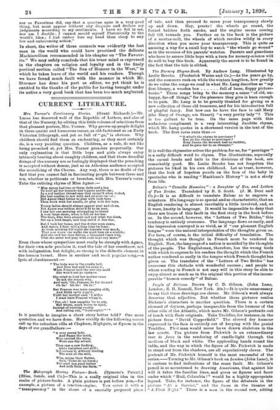People of Dickens. Drawn by C. D. Gibson. (John Lane;
London ; R. H. Russell, New York. 20s.)—It is quite unnecessary to say that these drawings are clever. Mr. Gibson's work always deserves that adjective. But whether these pictures realise Dickens's characters is another question. There is a certain element of dryness, perhaps inseparable from the humour of the other side of the Atlantic, which make Mr. Gibson's portraits out of touch with their originals. Take Traddles, for instance, in the picture from "David Copperfield." The shrewd dry humour expressed in the face is entirely out of keeping with the genial Traddles. That man would never have drawn skeletons in the law courts. The picture from Pickwick is an extraordinary tour de force in the rendering of candle-light through the medium of black and white. The applauding hands round the table, and the way in which the figure of Mr. Pickwick is made to stand out from the shadows, are all superlatively clever. The portrait of Mr. Pickwick himself is the most successful of the series.—Turning to Mr. Gibson's book on London (John Lane), it is curious to find indications of the same fault. Mr. Gibson's pencil is so accustomed to drawing Americans, that against his will it takes the familiar lines, and gives us figures and faces under which "Hail, Columbia!" would be a highly appropriate legend. Take, for instance, the figure of the debutante in the picture "At a Barrier," and the faces in the theatre at " A First Night " There is a man in the second row, sitting between two girls, who was most undoubtedly born on the other side of the Atlantic. Of course it is, happily, an exceed- ingly common thing to see Americans in London society. But if Mr. Gibson intends the book to give "the extreme characteristic impression" of London people, it must be confessed he is not alto- .gether successful. Another hand (the hand of the artist whose excellent portrait Mr. Gibson has, whether intentionally or not, .sketched in "Distinguished Guests ") has photographed London .society for us with an accuracy and intimate knowledge to which Mr. Gibson has failed to attain, except in the pictures which do not deal with the social aspect of life in London. Nothing, fcr instance, could be better or more characteristic than Mr. Gibson's picture of the entrance to the pit of a popular theatre on a wet night; and the depressing look of the chairs in the park "After Hours" has been caught with great humour. The picture of what Mr. Gibson calls the sidewalk artist is good, but why " sidewalk " ? Even " pavement " would be no improvement, for just as crossing. sweepers dub themselves "landscape painters," so our familiar friend with the chalks has also taken a professional title, and likes to be known as a "flagstone artist."











































 Previous page
Previous page